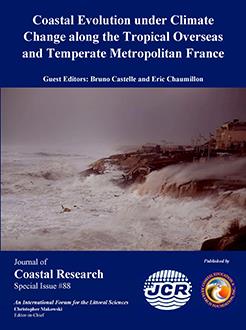Costa, S.; Maquaire, O.; Letortu, P.; Thirard, G.; Compain, V.; Roulland, T.; Medjkane, M.; Davidson, R.; Graff, K.; Lissak, C.; Delacourt, C.; Duguet, T.; Fauchard, C., and Antoine, R., 2019. Sedimentary coastal cliffs of Normandy: Modalities and quantification of retreat. In: Castelle, B. and Chaumillon, E. (eds.), Coastal Evolution under Climate Change along the Tropical Overseas and Temperate Metropolitan France. Journal of Coastal Research, Special Issue No. 88, pp. 46–60. Coconut Creek (Florida), ISSN 0749-0208.
This paper examines the spatial and temporal variations of cliff retreat rates over multi-temporal data of the Normandy cliffs. Data are derived from historical maps and aerial photographs and from recent lasergrammetry and photogrammetry monitoring. The diachronic analysis of all these data gives retreat rates of -0.1 to -0.5 m/yr. in line with the international literature. The spatial variations of the cliff retreat rates, at the Normandy scale, can be explained by geological structure, especially at the cliff foot, but also by the influence of cliff collapses or anthropogenic obstacles that disrupt the longshore drift. Multi-temporal data shows that the evolution of the cliffs occurs on scales from 10 to 70 years according to the lithology. The high resolution and frequency monitoring also provide information about the factors responsible for triggering gravitational landslides (rockfalls, slides, debris falls). The study proposes a regional warning threshold for the cliff characterized by landslides, under the dominating influence of rainfall and groundwater level evolution. In this respect the monitoring is inconclusive for chalk and limestone cliffs, because the origin of evolutions is more multifactorial (combination of more continental and marine processes).





